Trafalgar naval battle
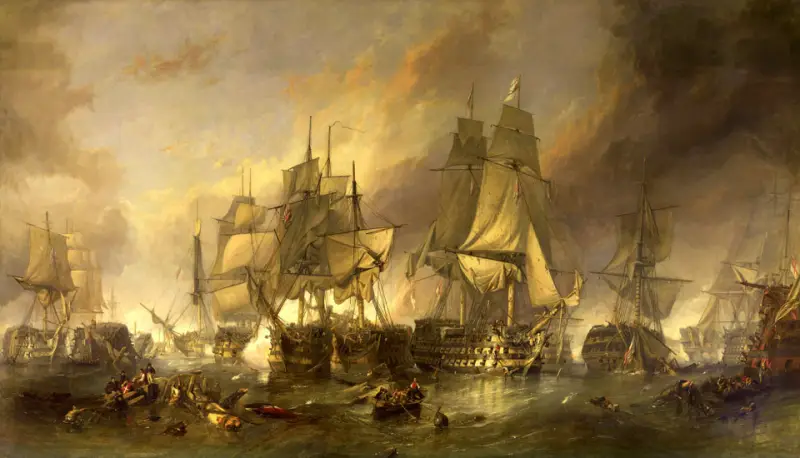
"Battle of Trafalgar", painting by W. Clarkson-Stanfield, painted in 1806
Most recently we talked about Bonaparte's Egyptian campaign and naval battle of Abukir, about the political situation in Europe on the eve of the War of the Third Coalition, about the causes and beginning of this war. Napoleon was preparing an invasion of England, the British were feverishly looking for allies whose armies would fight Bonaparte in Europe, distracting him from his plans to conquer their proud island. As you know, the British found allies - and they miserably lost this war. But England was saved. And the main battle of that war for the British themselves was the famous naval battle of Trafalgar. It is often said that in it England lost its best admiral, and France lost its fleet and hope of remaining a great naval power. The Battle of Trafalgar is traditionally included among the four largest naval battles in the world. stories - on a par with Salamis, Lepanto and Tsushima. The Battle of Trafalgar will be discussed in this article.
On the eve
On September 17, 1805, Napoleon signed an order according to which the Franco-Spanish squadron was to finally leave Cadiz and go to Cartagena, where other Spanish ships were to join it. At Toulon they were to take on French landing troops and proceed to Naples to support Saint-Cyr's army and also to threaten Egypt. The unsuccessful Vice-Admiral Pierre-Charles de Villeneuve had to surrender command to Count François-Etienne de Rosely (a famous French hydrographer and cartographer) and come to Paris “to give an explanation.” He received the letter with the order on September 27, and in order to save his honor, he decided to lead this expedition himself. For a long time he did not dare to go to sea, but now, when he was already in virtual retirement, he was eager to go into battle. But the Spaniards were against it. Admiral Federico Gravina pointed out that many sailors were sick, the crews were understaffed, the recruits were poorly trained, and the period of autumn storms was approaching. Villeneuve replied that
Meeting with the British
On October 19, French and Spanish ships left the harbor of Cadiz and headed for Gibraltar. In the early morning (about 5 hours 30 minutes) of October 21, British ships were discovered near Cape Trafalgar, they were led by Horatio Nelson, from whom the French admiral fled during the battle of Aboukir. And now Villeneuve himself had lost his courage: after much hesitation, he gave the order to turn back - to Cadiz. At about 8 o'clock in the morning a signal was raised: "Jibe, all of a sudden, heading north, in reverse order"- the vanguard ships now became the rearguard. This maneuver took two hours, and the battle formation was disrupted - “distance gaps” appeared; now the ship following could not protect the stern of the one in front. Some ships, in order not to collide with their neighbors, did not break down at all, which now looked like a crescent curved to the right - towards the shore. Nelson, intending to cut the enemy fleet into three parts, lined up his ships in two columns.
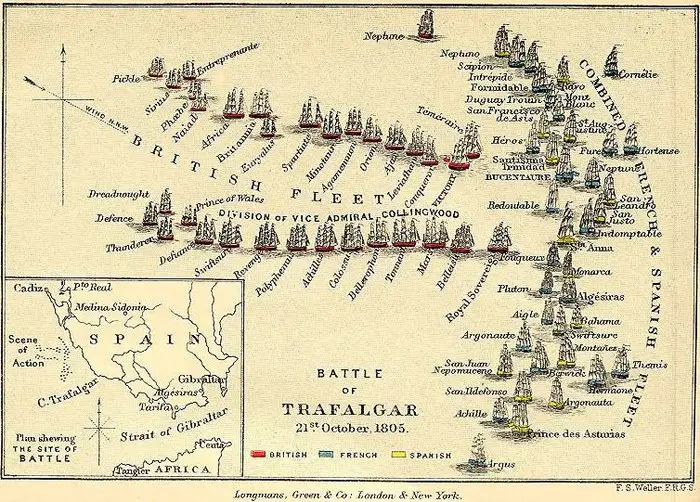
The plan was very bold, even risky, since the British ships approached the enemy at a heading angle of almost 90 degrees and therefore could not use their artillery. And enemy ships could hit them with volleys of onboard cannons. But the wind and ocean waves were favorable for the British.
Correlation of forces
What forces did the admirals of the opposing sides have at their disposal? Nelson had 27 battleships, 4 frigates and 1 schooner at his disposal. Villeneuve led a fleet of 33 battleships (18 French and 15 Spanish), 5 frigates and two brigs. As for the battleships, in Nelson's squadron 4 of them were ships of the first rank, 4 of the second, 20 of the third. In the unified Franco-Spanish navy there were 4 battleships of the first rank and 29 of the third. Villeneuve flew his flag on the 80-gun ship Bucentaure, which was covered by the Spanish 144-gun ship Santissima Trinidad (Holy Trinity).
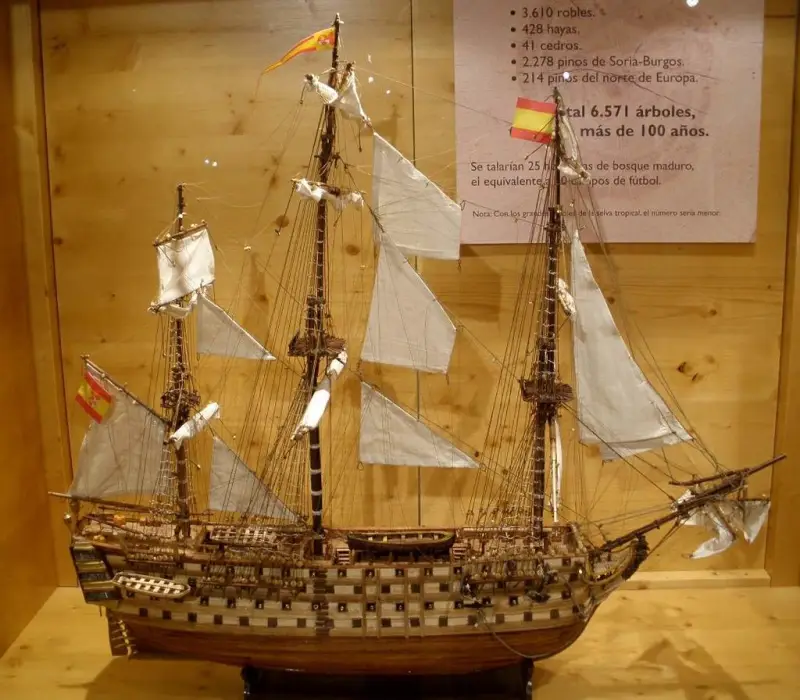
Santísima Trinidad, model of a ship in the Science Museum of Valladolid
Federico Gravina's flagship was the 112-gun battleship Principe de Asturias. Nelson was on the famous 104-gun battleship Victory, which had previously been the flagship of the talented British Admiral John Jarvis (Nelson served under Jarvis and learned much from him). Victory was only slightly younger than Nelson - laid down at Chatham on July 23, 1759 and launched in 1765. But in 1799-1803. this ship was undergoing repairs and was literally rebuilt log by log; they say that the cost of such reconstruction exceeded the cost of construction. Victory outlived Nelson, it remained in service until 1812, and then it was put into “eternal berth” in the city of Portsmouth:
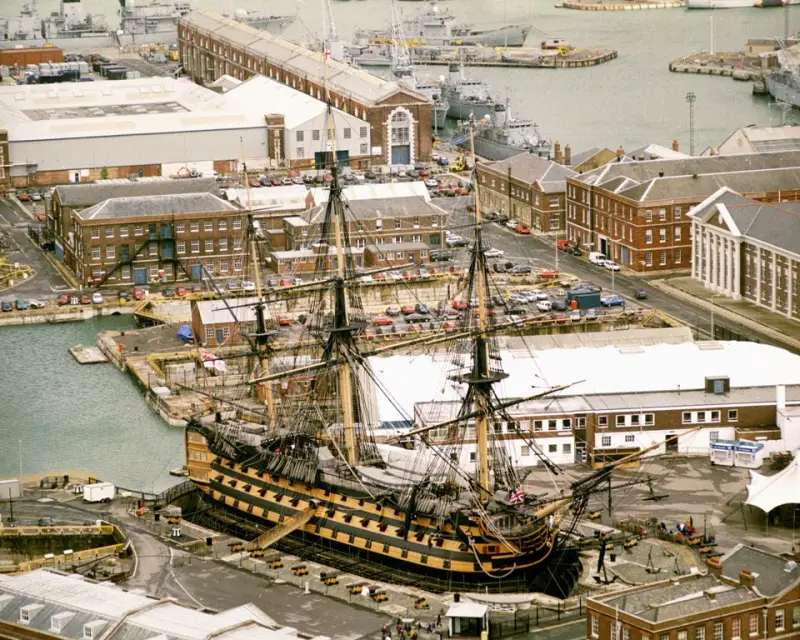
Nelson's deputy, Vice Admiral Cuthbert Collingwood, sailed on the 100-gun Royal Sovereign.
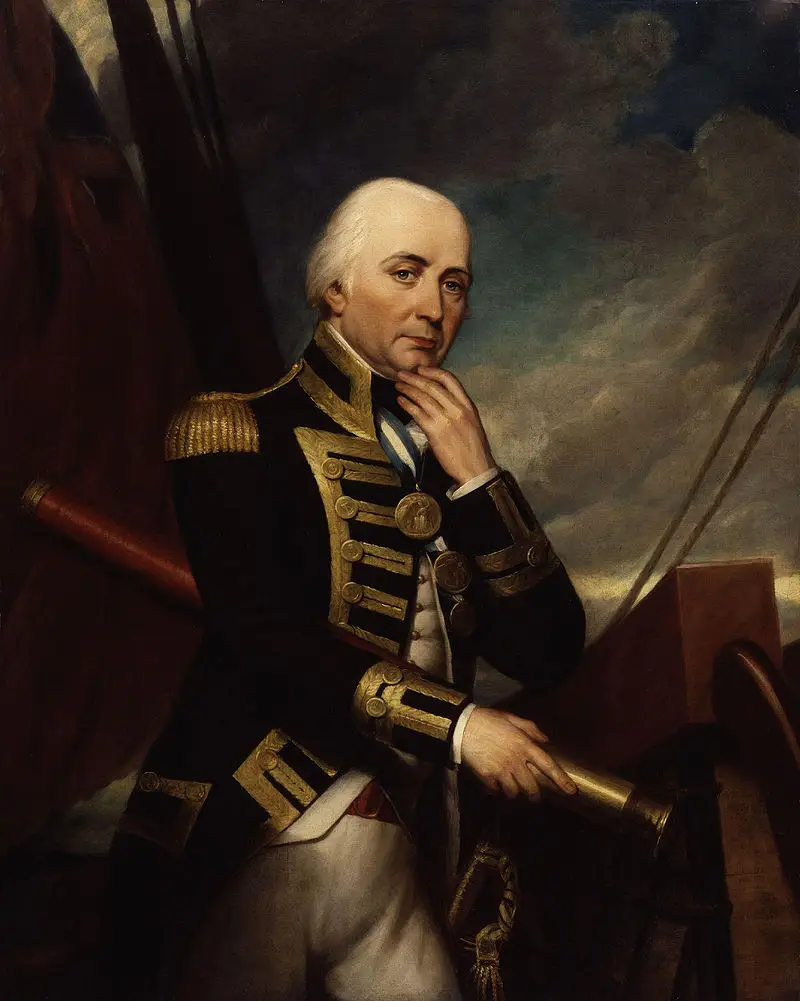
Cuthbert Collingwood in a portrait by Henry Howard
Among the French battleships was Swiftsure, which, as part of the English fleet, took an active part in the naval battle of Aboukir and successfully attacked the French flagship, L'Orient. It was the Swiftsure sailors who then presented Nelson with a coffin made from a piece of the Orient's mast that fell on the deck of their ship. However, in 1801, this ship was captured by the squadron of the French admiral Honoré Joseph Antoine Gantome.
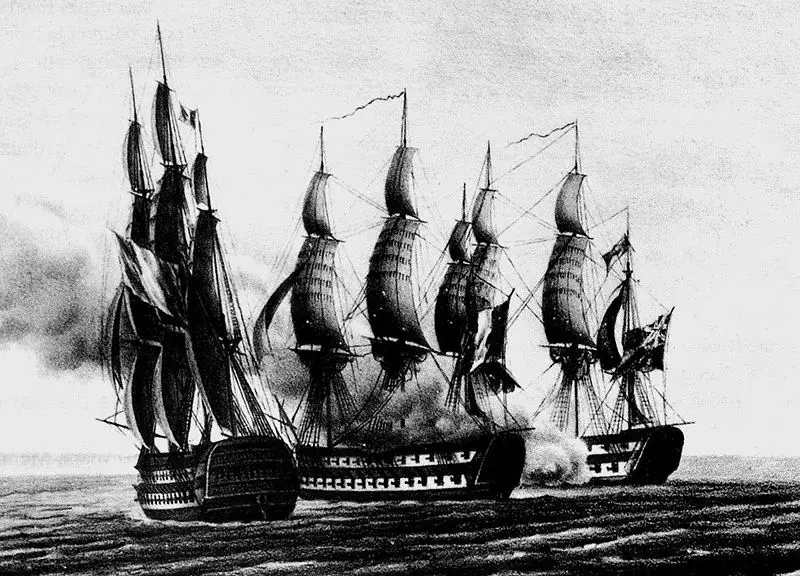
French ships l'Invincible and Le Dix-Août attack Swiftsure on 24 June 1801
And the British squadron included the former French ships Tonnant and Spartiate, captured during the Battle of Abukir.
The Allied ships carried 2864 artillery pieces, and the number of crews reached 20 thousand people. The British ships carried 2312 guns and about 16 sailors.
In the Battle of Abukir, the French fleet suffered heavy losses, including casualties. As a result, British sailors were more experienced and better trained. The difference in the level of the gunners was especially critical: some argue that the British were almost three times faster than their opponents in terms of rate of fire.
Nelson then made a very controversial and fatal decision - to wear a ceremonial uniform with orders. He was now an ideal target, and Victory officers asked him to dress less conspicuously. Nelson replied:
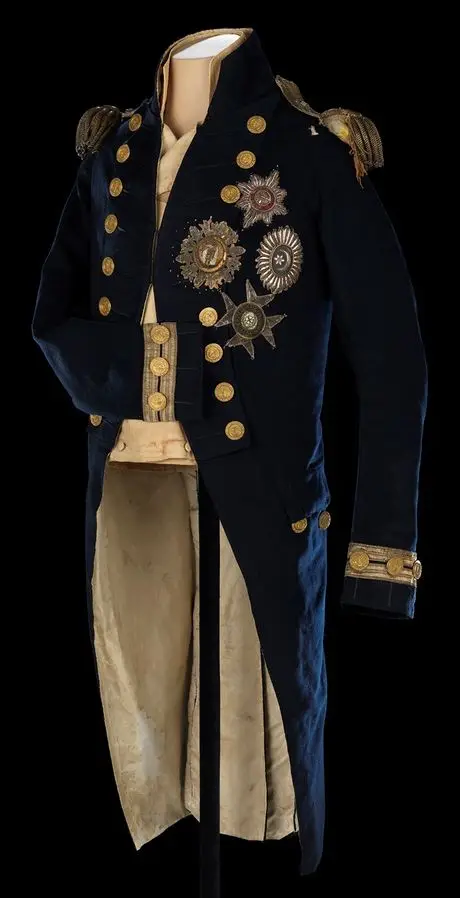
Nelson's Trafalgar uniform. Greenwich, National Maritime Museum
Before the battle began, he told his captains:
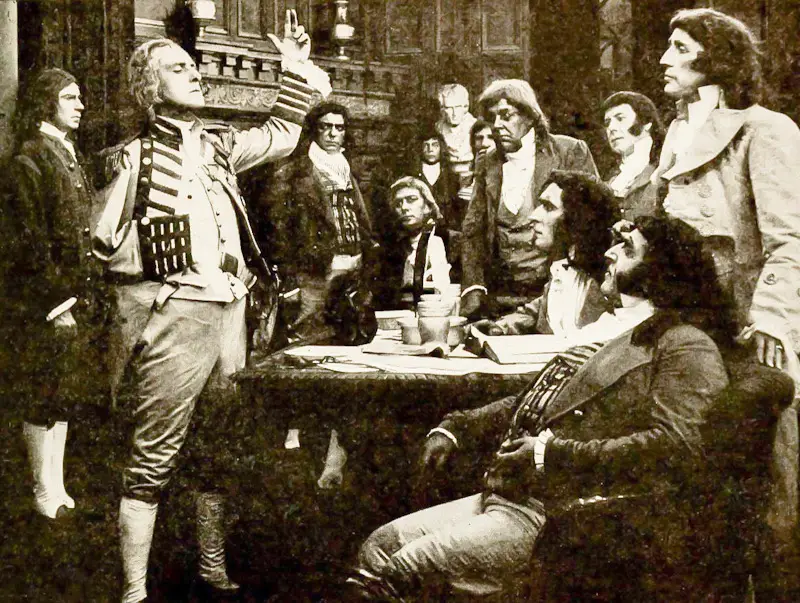
Nelson outlines the plan for the Battle of Trafalgar to his captains, still from the 1911 American film.
At about 12 noon, Nelson ordered a signal to be raised, which researchers are still arguing about. Some write that it read:
However, such a signal is simply impossible - the code used does not have the necessary notations. The most popular version says that the signal was as follows:
This phrase became the battle motto of the British Navy.
But skeptics argue that Nelson gave the usual signal - required by the charter:
The French ships raised the republican tricolor flags, the Spaniards raised the flags of their country and wooden crosses.
Battle
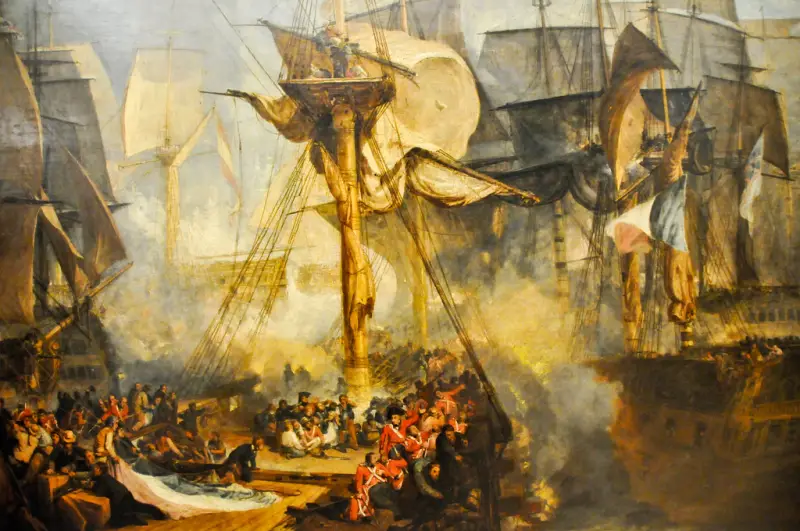
Joseph Mallord William Turner. The Battle of Trafalgar
So Nelson decided to attack the enemy fleet in two columns. The first to approach the Franco-Spanish fleet were 15 ships of Collingwood's column, which were tasked with cutting the enemy formation between 12 and 13 rearguard ships. However, in the end, the Franco-Spanish fleet was cut down to 16-17 ships, and Collingwood's ships were in the minority. The English ships also entered into battle not simultaneously, but in turn. Thus, their opponents had a good chance of success, however, as we remember, the English gunners fired three times faster. Nelson led a second column of 12 ships that attacked the center of the enemy formation.
It should be noted that the vanguard (former rearguard) ships of the French Vice Admiral Pierre Dumanoir, which had become separated from the main group of ships, continued to sail towards Cadiz. There were 9 of them, and they were joined by one ship of the central group. These ships began to turn back only at about 3 o'clock in the afternoon - too late, by this time the enemy had already captured 12 French ships. And 4 of them completely avoided the fight.
The first salvo of the Battle of Trafalgar was fired by the Spanish 112-gun ship Santa Ana, firing at Collingwood's flagship Royal Sovereign, which had rushed forward.
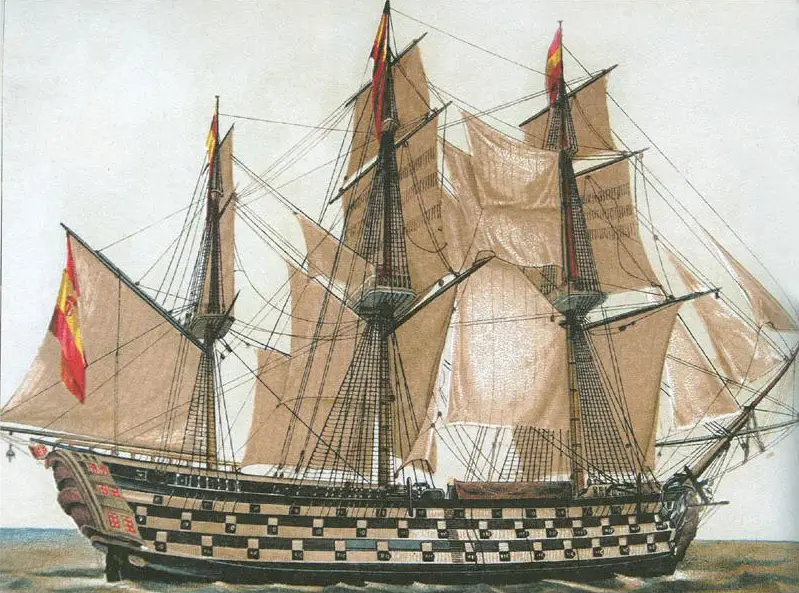
Santa Ana in an early 23th century engraving. This ship was captured by the British, but on October XNUMX was recaptured by Federico Gravina, returned to Cadiz, and then, together with the Príncipe de Asturias, was transferred to Cuba
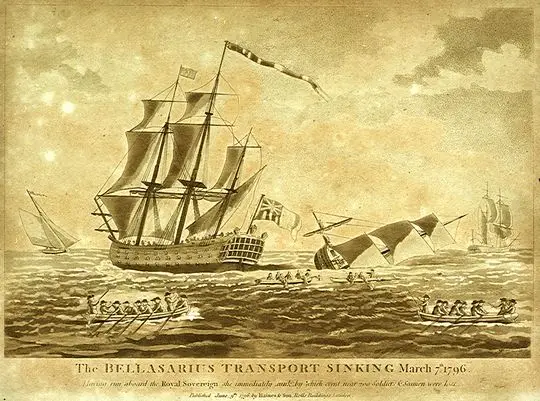
Royal Sovereign in an engraving from 1796
At about half-past twelve, Collingwood's ship cut through the enemy formation and for about 15 minutes fought alone and was badly damaged. But the Royal Sovereign’s guns were not silent: the Spanish battleship Santa Anna and the French Fugue took a heavy toll. Then other English ships began to approach. Nelson's column entered the battle half an hour later.
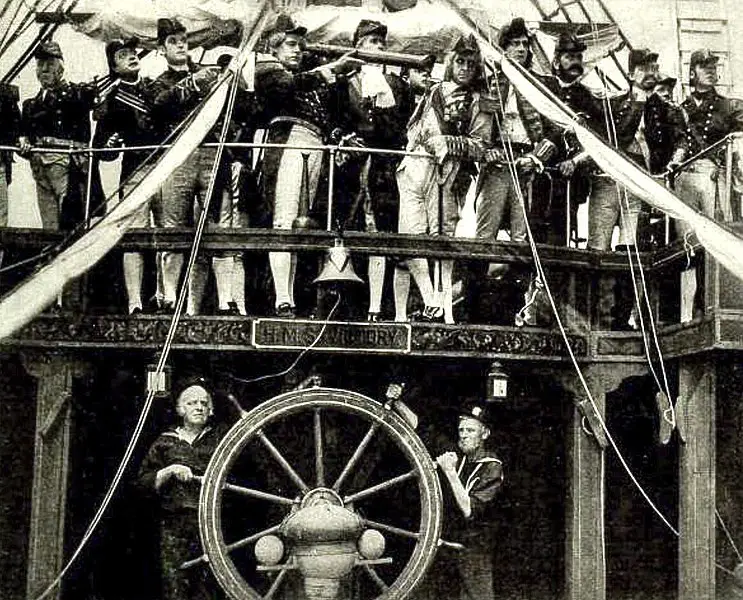
Nelson and his officers on the deck of the Victory approaching enemy ships, still from the American film 1911.
The flagships of Nelson and Villeneuve, Victory and Bucentaur, met in battle. The French fired three salvos, knocking down one of the Victory's masts, but then either six or seven British ships hit the Bucentaur. Nelson's flagship passed the Bucentaur and found itself in front of the battleship Redoutable. Bucentaur was now tackled by the 98-gun English ship Temerair.
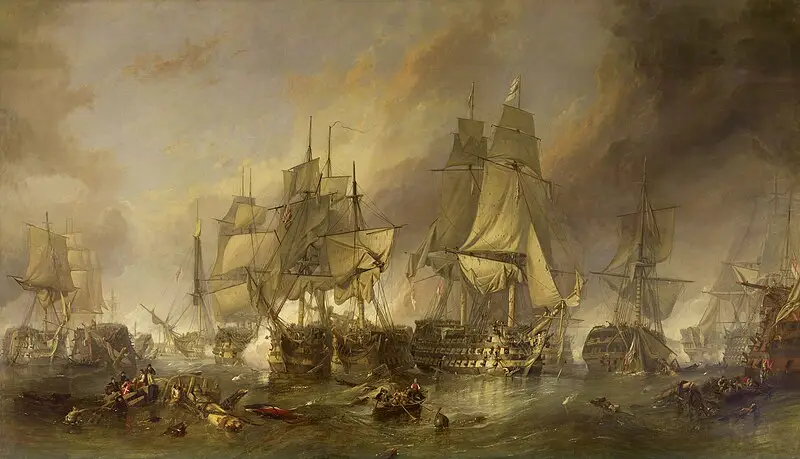
The French battleship Redoutable (center) and the British Victory and Timirer in Clarkson's painting by Frederick Stanfield
During the Battle of Trafalgar at sea, there was a strong rolling motion, which, on the one hand, interfered with aimed fire, and on the other, disrupted the formation of the Franco-Spanish fleet, which found itself “cut up” in several places. The battle turned into a series of confrontations between individual ships, which fired at each other almost point-blank - not only from cannons, but also from handguns weapons. Such fights ended in boarding battles. It was then that the gunner of the French ship Redoutable, who was on the mizzen mast, mortally wounded Nelson, who was clearly visible thanks to his ceremonial uniform, from a distance of 14-15 meters. The bullet passed through the shoulder, pierced the lung and got stuck in the spine, the admiral was paralyzed in the lower part of his body.
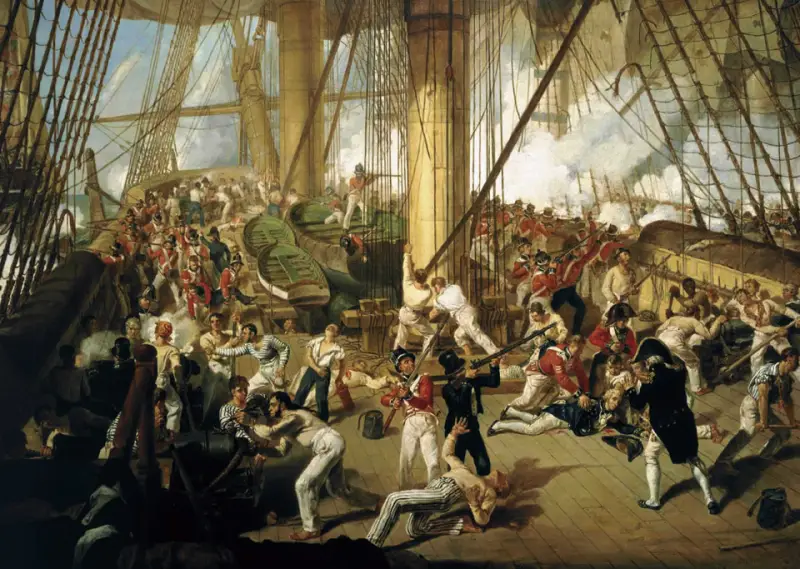
Nelson's wound in the painting by D. Digton
Nelson was conscious and demanded reports on the progress of the battle. At 4 o'clock in the afternoon, the captain of Victory informed him that 15 enemy ships had already been captured (including the French flagship, which had lost all its masts) and the battle had been won. Nelson is said to have responded:
He died 30 minutes later. According to the official version, the admiral's last words were:

Benjamin West. Death of Admiral Nelson
It should be noted that the battleship Redoutable, from which Nelson’s fatal shot was fired, was captured by his flagship, Victory. During the desperate boarding battle, the French lost 80% of the crew. The huge four-deck battleship Santissima Trinidad was also captured, which was forced to fight with seven British ships. The beating of the Franco-Spanish fleet was stopped by a storm.
The Spanish admiral Federico Gravina showed himself excellently in this battle, and continued to lead the battle even after losing an arm. He managed to take some of the ships to Cadiz, where they took refuge from the storm. The next day, despite being wounded, Gravina again led the remaining combat-ready ships to sea. It was possible to recapture the battleship Santa Ana, whose crew had mutinied against the British on board, but Gravina's two other ships sank during the ongoing storm.
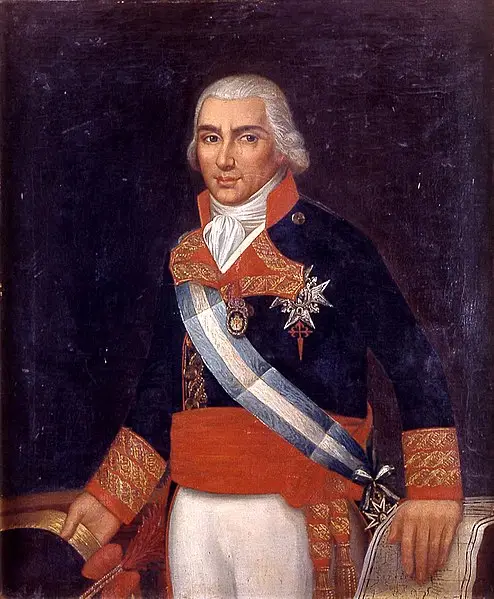
Federico Carlos Gravina i Napoli in a portrait by an unknown artist
The Spanish admiral was never able to recover from the consequences of the wounds he received during the Battle of Trafalgar. He died on March 9, 1806, aged only 49.
After the battle
The results of the battle were as follows. The British did not lose a single ship; 458 of their crews were killed and 1208 were wounded. The combined Franco-Spanish fleet lost 22 ships (one was sunk, the rest were captured). The crews of the ships suffered heavy losses: 4395 people were killed, 2540 were wounded, about eight thousand were captured (including de Villeneuve). Up to three thousand French and Spanish sailors who had already surrendered drowned during a fierce storm on October 22, at the same time three ships that were captured by the British, including the Santissima Trinidad, sank. And on November 4, 1805, the squadron of Captain Richard Strachan intercepted 4 French ships of Rear Admiral Pierre Dumanoir, which left Trafalgar without taking part in the battle. These ships were captured and brought to England.
Nelson's body was brought to London in a barrel of brandy. They said that sailors drank this drink on the way - with the help of straws. It is difficult to say how reliable these stories are, but the rum that was given to English sailors actually began to be called “admiral's blood" or even "Nelson's blood».
Horatio Nelson's dream of a funeral in Westminster Abbey never came true: St. Paul's Cathedral became his burial place. And he was buried in a coffin made from a fragment of the mast of the French flagship, which the sailors of the battleship Swiftsure gave him after the Battle of Aboukir.
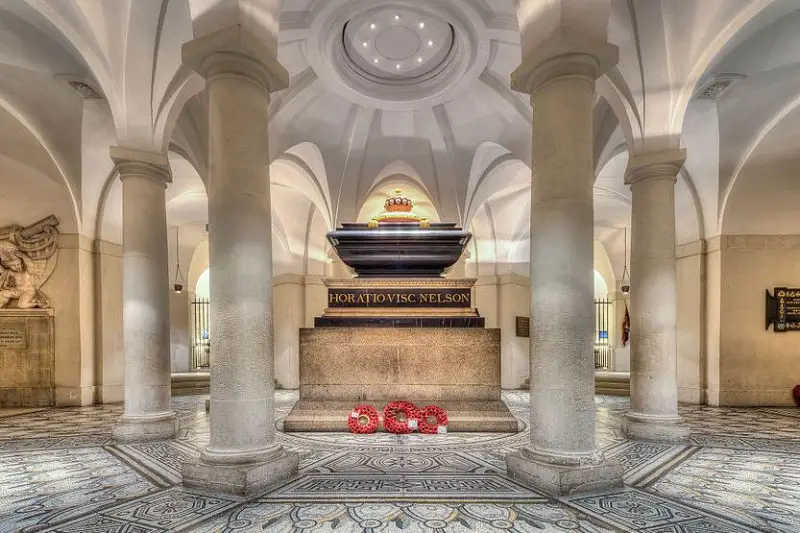
Nelson's headstone, St Paul's Cathedral, London
The captured commander of the combined Franco-Spanish fleet, Vice Admiral Villeneuve, was also present at this funeral. After a year and a half, he was released on his word of honor not to fight the British. On April 22, 1806, his body was found in one of the rooms of the inn where he stayed, awaiting Napoleon's orders. According to the official version, de Villeneuve, who feared the tribunal, committed suicide.
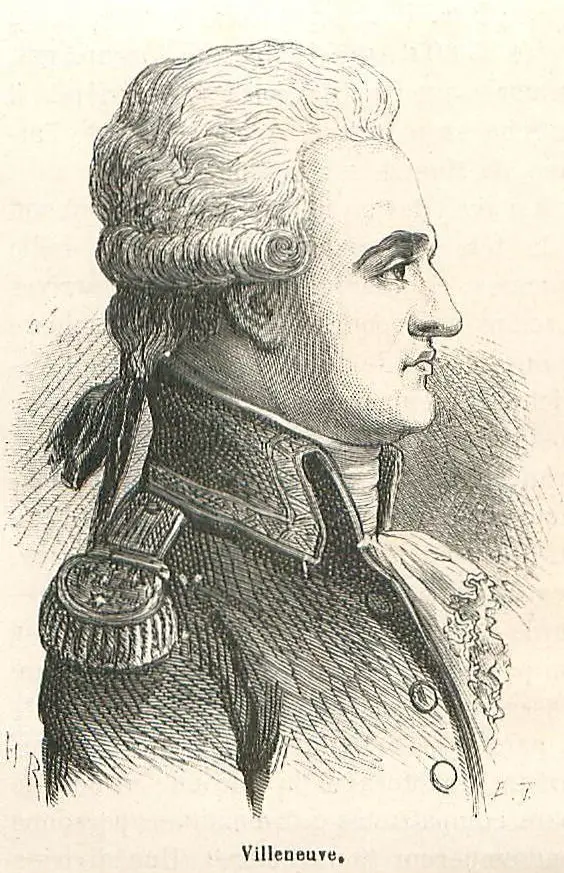
Pierre-Charles Villeneuve
In London, a square that was previously named after William IV was named in honor of the Trafalgar victory. It is located where the Strand, Whitehall and Mall streets meet. In 1842, in its center, on a granite column 46 meters high, a statue of Nelson, three times the height of a man, was installed. Alexander Herzen, by the way, called this column “a bad monument to a bad man».
The pedestal of the column is decorated with bronze panels depicting four of Nelson's famous victories - they are cast from captured French artillery pieces. And the metal of English cannons was used to decorate the upper part of the column.

Trafalgar Square, London
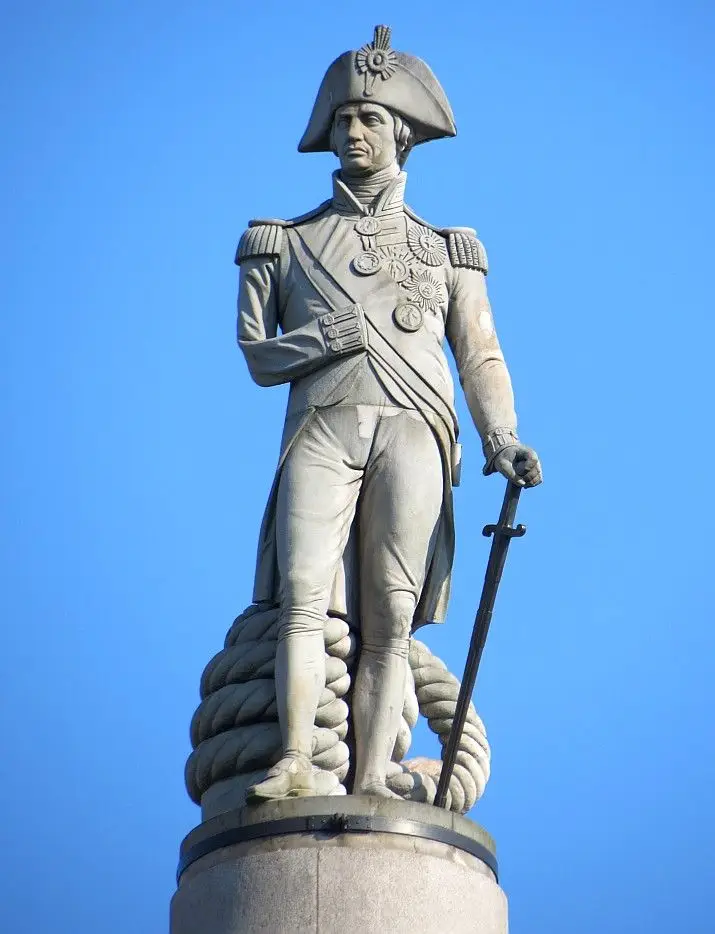
Nelsons column in London
It is curious that the construction was carried out with financial assistance from Russia: the government of our country wanted to improve relations with England.
The last surviving flag from an English ship that took part in the Battle of Trafalgar “surfaced” at an auction held in London on October 21, 2009, the 204th anniversary of the battle. With an original asking price of £14, this historically valuable relic sold for £000. Agree, the price is not too high - compared to the prices of some modern “works of art”.
Of first article You may remember that a few hours before his death, Nelson explicitly stated in his will:
England thanked its hero, leaving the admiral's beloved woman and his daughter without a livelihood. Upon receiving the news of Nelson's death, Emma Hamilton went to bed with a fever for two weeks. Having come to her senses, she learned that Nelson's will had not been recognized, and very soon she found herself in debtor's prison. Upon release, she rented a room in the attic, soon found herself in debt again and was forced to hide from creditors in France. Here, out of grief and hopelessness, she began to “hung to the bottle” and soon became an alcoholic. She died in complete poverty on January 15, 1815. Her daughter Horatia returned to England, married a priest and had 10 children (seven sons and three daughters).
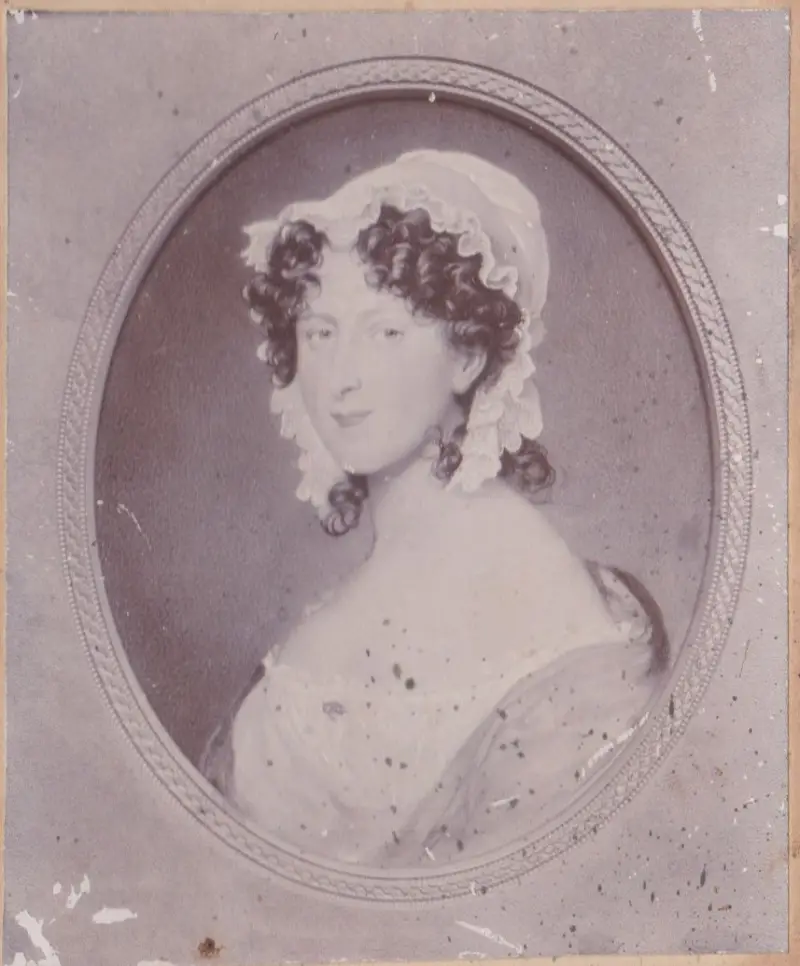
Horatia, daughter of Admiral Nelson and Lady Hamilton
Only at the end of her life did she manage to obtain from the English government a one-time subsidy of 1457 pounds sterling (Horace distributed this money among her sons) and a “pension” for her daughters - 100 pounds annually. She died at the age of 80. On the gravestone she is named not as her own daughter, but as Nelson's adopted daughter.
Information